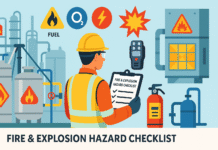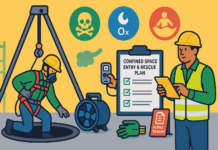
Shuttering and De-shuttering Work HIRA (Hazard Identification and Risk Assessment)
Shuttering (formwork) is a temporary mold used to hold wet concrete in place until it hardens. De-shuttering is the removal of this formwork after the concrete has achieved the required strength. These processes are essential in construction but present several hazards, including working at height, falling formwork, falling objects, manual handling injuries, and premature removal.
A well-structured HIRA ensures that these tasks are performed safely by identifying and controlling potential risks.
Objective of Shuttering and De-shuttering HIRA
- To identify hazards related to shuttering and de-shuttering activities.
- To assess risks based on likelihood and severity.
- To implement suitable engineering, administrative, and PPE controls.
- To ensure structural integrity and safety of workers during operations.
Scope
This HIRA covers:
- Erection of shuttering/formwork for columns, beams, slabs, and foundations
- Use of steel, timber, or aluminum shuttering materials
- Support systems like props, jacks, and ties
- Removal of shuttering components after curing
- Safe handling, transportation, and stacking of shuttering material
Step-by-Step HIRA for Shuttering and De-shuttering Work
1. Activity Description
Erecting formwork to shape and support concrete during curing and removing it once the concrete has sufficiently hardened.
2. Hazard Identification Table
| S. No. | Hazard | Potential Effects | Persons at Risk |
|---|---|---|---|
| 1 | Collapse of improperly erected shuttering | Crush injury, fatality | Formwork crew |
| 2 | Falling from height during erection/removal | Fracture, head injury, death | Shuttering workers |
| 3 | Falling tools or materials | Head/eye injuries | Workers below |
| 4 | Manual handling of heavy components | Back injury, strain | Laborers, carpenters |
| 5 | Premature removal of formwork | Structural damage, collapse | Entire site crew |
| 6 | Sharp edges of shuttering materials | Cuts, lacerations | Handlers |
| 7 | Use of damaged/formwork components | Instability, collapse | Shuttering team |
| 8 | Slips/trips on form oil or debris | Falls, sprains | Workers on platform |
| 9 | Improper stacking of materials | Collapse, struck-by injuries | Laborers |
| 10 | Electric shock near rebar or exposed wiring | Burn, electrocution | Workers near embedded systems |
3. Risk Assessment Matrix
Risk Rating = Likelihood (L) × Severity (S)
Scale: 1–5 for both L and S
| Hazard | L | S | Risk Rating | Risk Level |
|---|---|---|---|---|
| Collapse of formwork | 3 | 5 | 15 | High |
| Fall from height | 4 | 5 | 20 | Critical |
| Falling objects | 3 | 4 | 12 | High |
| Manual handling | 4 | 3 | 12 | High |
| Premature removal | 2 | 5 | 10 | High |
| Cuts from sharp edges | 4 | 2 | 8 | Medium |
| Damaged components | 3 | 4 | 12 | High |
| Slips on oil | 3 | 3 | 9 | Medium |
| Improper stacking | 3 | 3 | 9 | Medium |
| Electrical hazards | 2 | 5 | 10 | High |
4. Control Measures
Engineering Controls:
- Use modular formwork systems with certified load ratings.
- Install edge protection, guardrails, and work platforms.
- Provide secure access ladders and scaffolding for elevated work.
- Use mechanical lifting devices for handling heavy components.
- Ensure stable props, supports, and ties with locking pins.
Administrative Controls:
- Conduct structural stability checks before de-shuttering.
- Issue Permit to Work (PTW) for shuttering/dismantling jobs.
- Implement a tagging system for defective formwork materials.
- Plan removal sequence to prevent imbalance or toppling.
- Conduct toolbox talks and safety briefings before work.
Personal Protective Equipment (PPE):
- Safety helmets with chin straps.
- Cut-resistant gloves.
- Steel-toe safety boots.
- Safety harness and lifeline for height work.
- Reflective vests and safety goggles.
5. Safe Work Procedure (SWP)
Before Shuttering:
- Review formwork design drawings and load specifications.
- Inspect shuttering panels and support systems for damage or defects.
- Clean the work area of debris and check for flat, stable surfaces.
- Assign trained personnel and brief on sequence and responsibility.
- Mark working zone and restrict access to unauthorized personnel.
During Shuttering:
- Begin from base to top; maintain symmetry to avoid structural stress.
- Tighten clamps, pins, and jacks securely.
- Check verticality and alignment continuously.
- Secure all tools to prevent falling.
- Do not remove any support until full formwork is complete.
During De-shuttering:
- Wait for the required curing period (as per engineer’s instruction).
- Remove shuttering in reverse sequence of erection.
- Use appropriate tools to loosen parts—no hammering on green concrete.
- Clear each component immediately after removal.
- Stack materials in a safe, stable manner away from work zones.
6. Emergency Preparedness
- First aid kits available near working area.
- Rescue plans for falls or collapse incidents.
- Designated escape routes from elevated zones.
- Fire extinguisher ready in case of electrical hazard.
- Trained first aiders on every shift.
7. Roles and Responsibilities
| Role | Responsibility |
|---|---|
| Site Engineer | Approve formwork design and de-shuttering timeline |
| HSE Officer | Conduct inspections, monitor safety compliance |
| Supervisor | Allocate tasks, enforce procedures, check quality |
| Shuttering Workers | Use tools and equipment safely, report defects |
| Carpenter Foreman | Ensure correct installation and material integrity |
| First Aider | Provide immediate response for cuts, falls, or other injuries |
Summary of Key Recommendations
- Use certified, tested shuttering systems and components.
- Do not begin de-shuttering until concrete has reached sufficient strength.
- Implement fall protection measures during elevated work.
- Enforce safe stacking and transport of panels and supports.
- Train all workers on erection and dismantling sequences.
- Clearly mark hazardous zones and prevent unauthorized access.
- Use a tagging system to identify damaged or unsuitable formwork items.
- Provide adequate lighting and access platforms in confined or high areas.
Monitoring and Review
- Daily checklist for formwork erection and dismantling compliance.
- Weekly inspection of tools, supports, and material conditions.
- Incident logbook maintained and reviewed monthly.
- Regular updates to HIRA after changes in design or method.
- Periodic retraining for shuttering crew on safety practices.
Conclusion
Shuttering and de-shuttering are high-risk operations that require precision, planning, and constant supervision. A systematic HIRA process helps in preventing collapses, injuries from falling materials, and unsafe handling practices. By ensuring quality equipment, trained workers, and strict monitoring, formwork activities can be conducted safely and efficiently.
Safety in shuttering is not just about structure—it’s about protecting every life involved in the construction process.
Site Housekeeping Activities HIRA (Hazard Identification and Risk Assessment)
Tower Crane Operation HIRA (Hazard Identification and Risk Assessment)
Demolition Work HIRA (Hazard Identification and Risk Assessment)
Rebar Cutting and Bending HIRA (Hazard Identification and Risk Assessment)
Concreting and Formwork HIRA (Hazard Identification and Risk Assessment)
























